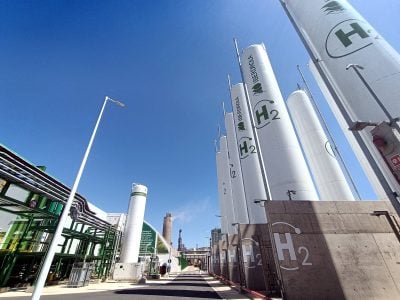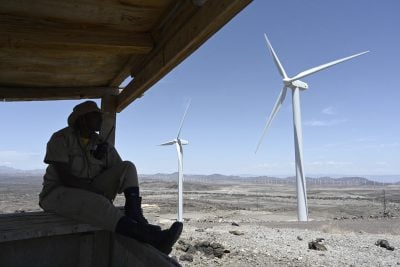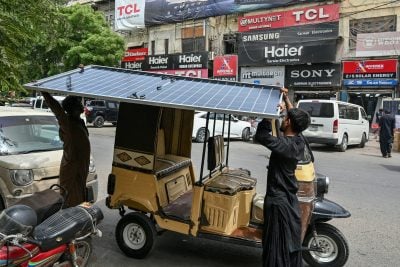With the opening of a new solar power plant in Morocco and the announcement of a wave of new projects in other North African states, the idea of a North African solar power industry transmitting energy to Europe and each other is back in the news again. But while the idea has potential, a pan-North African solar power sector in its current form seems likely to be met by fractious and nationalistic governments.
Morocco has announced it is on course to build the world’s largest solar power plant after completing the first phase of a new complex near the town of Ouarzazate. The Noor 1 project, consisting of 500,000 solar mirrors, will be joined in 2017 by two other plants, Noor 2 and 3, and a fourth phase is now being mooted. Once the whole complex is complete the solar plant at Ouarzazate will generate 580 MW at peak output. Parts of the complex will also be able to store electrical power using molten sand during the night. It is an electrical generation system perfectly designed to work in a hot desert country like Morocco, but it cost $9bn USD to make.
Morocco is prepared to spend such sums because it is the biggest energy importer in North Africa, already spending over $3bn a year on fuel and electricity imports, while experiencing a growth in power demand of 6.5% a year. With almost complete dependence on imported energy carriers, renewable energy is an attractive proposition for the state domestically regardless of the industry’s nascent export potential. The country is aiming to generate 42% of its energy from renewable sources by 2020 and has a host of initiatives being built. It already hosts Africa’s largest windfarm at Tarfaya, which began commercial operations in January, plus a 470MW hybrid solar-gas plant called Ain Beni Mathar is planned for a location 650km east of the capital Rabat. Now neighbours like Tunisia are scrambling to follow suit with projects of their own.
But while Morocco is the poster child of clean energy, having realised the potential of solar power and other renewables early on, it also encapsulates some of the challenges facing any pan-North African energy export industry. Regional rivalries are intense and often frustrate projects requiring cross-border cooperation in the area. Nothing shows this better than Rabat’s relations with its giant neighbour Algeria, with whom it competes for local hegemony. Despite sharing a joint electrical grid the border between the two has been sealed since 1994, when Algiers shut it in retaliation for Morocco’s introduction of visas for Algerian visitors. Morocco put the visa regime in place as a security measure during Algeria’s civil war from 1991-2002. But despite the war’s end over ten years ago, the border remains closed because Algeria’s President Abdelaziz Bouteflika, in power since 1999, refuses to lift the measure.
The trend in the region is for each state to seek investors for its own renewable energy projects rather than seek a framework for a larger, common cross-Mediterranean transmission system. Thus in Tunisia a partnership between Tunisian investors and British firm Nur Energie called TuNur is focusing on exporting solar energy from there back to the UK only. In Egypt Saudi and South Korean investors are organising a $6 billon solar power project for that country’s portion of the Sahara in the Wadi Gedid governorate. Meanwhile the Algerian energy ministry announced plans to raise its 2030 target for renewable energy capacity from 12,000 MW to 25,000 MW in January 2015, but despite its shared electricity grid with Morocco there are no plans for cooperation between the two neighbours.
Yet a glance at the map of the failed German-backed Desertec project shows that a huge network of solar and wind farms could be built to stretch across the Middle East and North Africa region (MENA) region, connected to Europe via high voltage direct current transmission cables (which only lose 3% of their electricity per 1000km, or 620 miles). Where the plan fails is with current levels of grid interconnectivity between the Maghreb and Europe, and within Europe itself. At present Morocco is the only MENA country connected to Europe (via Spain) and it uses this connection to import electricity during peak demand times, not export it. Even plans for an energy union and better connections between EU member states, sped up by concerns over Russia’s geopolitical use of gas, are at an embryonic stage, never mind the MENA states.
EU plans currently focus on building missing cross-border links between the Iberian Peninsula and the rest of the EU energy market, with a target of ensuring that 10% of each EU member country’s power can be transported abroad by cable by 2020. That gels with the pre-existing infrastructure joining Spain, Morocco and Algeria, and could eventually be used as starting off point for the first phase of a pan-Mediterranean transmission system linking MENA countries with each other and the EU. For this to happen however first the narrow and nationalistic mentality of MENA governments would have to be changed enough to achieve the infrastructural integration and security cooperation required to build and protect such a system.
North Africa is littered with unresolved border disputes and security issues preventing just this, and while local states have failed to manage their own security individually they guard the privilege of doing so jealously. The two natural leaders of the region, Morocco and Algeria, are still politically deadlocked over the issue of the territory of Western Sahara, which Morocco occupies. Meanwhile Algeria still backs the independence-seeking Polisario guerrilla front, though the group has been on ceasefire since 1991. A quarter of a century has passed while this major security issue has sat unresolved by the two governments. Until negotiations and compromise over issues like this become more accepted in MENA politics, gigantic projects like a North African solar industry will continue to be frustrated. In the meantime each state in the region will continue to develop its own solar industry and the expertise to manage it. In the future these separate links may one day form a single chain connecting the region with Europe, as the backers of the original Desertec had envisaged. But industry watchers should not expect it for many years yet.
Want to continue reading? Subscribe today.
You've read all your free articles for this month! Subscribe now to enjoy full access to our content.
Digital Monthly
£8.00 / month
Receive full unlimited access to our articles, opinions, podcasts and more.
Digital Yearly
£70.00 / year
Our best value offer - save £26 and gain access to all of our digital content for an entire year!
 Sign in with Google
Sign in with Google 


